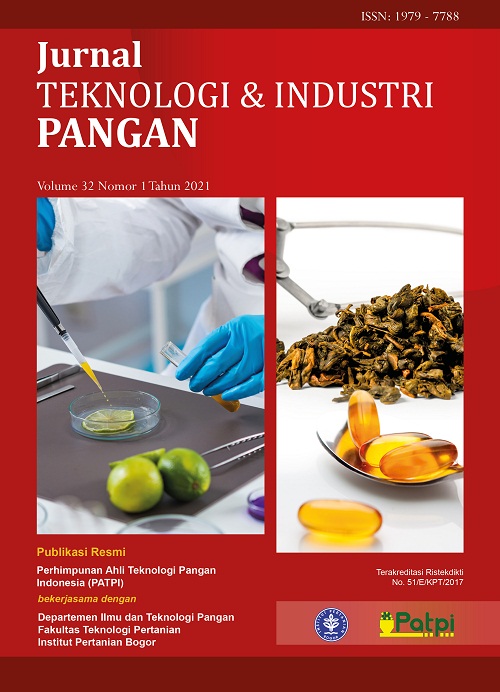STUDY OF FOOD ADDITIVES COMPOSITION IN COMMERCIALLY PROCESSED BEEF PRODUCTS
Abstract
Beef is one of the favorite red meats containing various essential nutrients. In the processed beef products, food additives are used for multiple purposes including preservation, moisture and texture re-tention, improvement of flavor and stability of color. The purpose of this study is to identify the food additives composition of halal and local-based commercially processed beef products based on the label of the products and the Indonesian regulations. There were 40 various commercially processed beef pro-ducts assessed in this study. The food additives that were observed were flavor enhancers, preservatives, stabilizers, antioxidants, acidity regulators, and colorants. The types of food additives used in beef sausage products were stabilizers (30.00%), preservatives (25.56%), flavor enhancers (15.56%), colorants (14.44%), antioxidants (13.33%) and acidity regulator (1.11%). In beef balls products there were stabilizers (50.00%), flavor enhancers (20.00%), preservatives (15.00%), antioxidants, acidity regulators and co-lorants (5.00% each). The additives in beef burgers products include stabilizers (29.73%), preservatives (24.32%), colorants (21.62%), flavor enhancers (13.51%), antioxidants and acidity regulators (5.41% each). Corned beef products contain preservatives (32.00%), flavor enhancers and antioxidants (24.00% each), and stabilizers (20.00%). Additionally, smoked beef products use preservatives (50.00%), stabilizers (37.50%) and antioxidants (12.50%). The only food additives used in beef floss products was flavor enhancer (100%). The study suggests that Government Regulations on food additives should be reconsidered. Although the additives are still allowed in Indonesian regulations at the present, food additives of which are included in the list of carcinogenic agents shall be limited or even avoided. Future research to find safer alternatives for those food additives is recommended.
References
Alomirah H, Al-Zenki S, Al-Hooti S, Zaghloul S, Sawaya W, Ahmed N, Kannan K. 2011. Con-centrations and dietary exposure to polycyclic aromatic hydrocarbons (PAHs) from grilled and smoked foods. Food Control 22: 2028-2035. DOI: 10.1016/j.foodcont.2011.05.024.
Binnie MA, Barlow K, Johnson V, Harrison C. 2014. Red meats: time for a paradigm shift in dietary advice. Meat Sci 98: 445-451. DOI: 10.1016/j. meatsci.2014.06.024.
[BPOM] Badan Pengawas Obat dan Makanan. 2016. Peraturan Kepala BPOM RI No. 21 Tahun 2016 tentang Kategori Pangan. BPOM, Jakarta.
Bouvard V, Loomis D, Guyton KZ, Grosse Y, Ghissassi FE, Benbrahim-Tallaa L, Guha N, Mattock H, Straif K. 2015. Carcinogenicity of consumption of red and processed meat. Lancet Oncol 16: 1599-1600. DOI: 10.1016/ S1470-2045(15)00444-1.
Candan T, Bagdath, A. 2017. Use of natural antioxidants in poultry meat. CBU J Sci 13: 279-291.
Chan DSM, Lau R, Aune D, Vieira R, Greenwood DC, Kampman E, Norat T. 2011. Red and pro-cessed meat and colorectal cancer incidence: Meta-analysis of prospective studies. PLoS One 6: 1-11. DOI: 10.1371/journal.pone.00204 56.
[EFSA] European Food Safety Authority. 2017. Re-Evaluation of potassium nitrite (E 249) and sodium nitrite (E 250) as food additives. EFSA J 15: e04786. DOI: 10.2903/j.efsa.2017.4786.
Falowo AB, Fayemi PO, Muchenje V. 2014. Natural antioxidants against lipid-protein oxidative dete-rioration in meat and meat products - a review. Food Res Int 64: 171-181. DOI: 10.1016/j. foodres.2014.06.022.
Fadlillah HN, Nuraida L, Purnomo EH. 2015. Kepedulian konsumen terhadap label dan informasi bahan tambahan pangan (BTP) pada label kemasan pangan di kota Bogor. J Mutu Pangan 2: 119-126.
Felter SP, Llewelyn C, Navarro L, Zhang X. 2020. How the 62-year old delaney clause continues to thwart science: Case study of the flavor substance β-myrcene. Regul Toxicol Pharmacol 115: 104708. DOI: 10.1016/j.yrtph.2020.1047 08.
Ferysiuk K, Wójciak KM. 2020. Reduction of nitrite in meat products through the application of various plant-based ingredients. Antioxidants 9: 711. DOI: 10.3390/antiox9080711.
Gharsallaoui A, Oulahal N, Joly C, Degraeve P. 2016. Nisin as a food preservative: Part 1: Physicochemical properties, antimicrobial acti-vity, and main uses. Crit Rev Food Sci Nutr 56: 1262-1274. DOI: 10.1080/10408398.2013.7637 65.
Iammarino M, Mentana A, Centonze D, Palermo C, Mangiacotti M, Chiaravalle AE. 2019. Simul-taneous determination of twelve dyes in meat products: development and validation of an analytical method based on HPLC-UV-diode array detection. Food Chem 285: 1-9. DOI: 10.1016/j.foodchem.2019.01.133.
Incoronato AL, Gammariello D, Conte A, Del Nobile MA. 2016. Ready-to-cook fresh meal: Study for shelf life prolongation. J Food Sci Technol 53: 990-995. DOI: 10.1007/s13197-015-2136-1.
[IARC] International Agency for Research on Cancer WHO. 2019. IARC Monographs on the Identification of Carcinogenic Hazards to Humans: Preamble. Amended January 2019. Lyon, France.
Karpińska-Tymoszczyk M. 2013. The effect of oil-soluble rosemary extract, sodium erythorbate, their mixture, and packaging method on the quality of Turkey meatballs. J Food Sci Technol 50: 443-454. DOI: 10.1007/s13197-011-0359-3.
Long NHBS, Gal R, Bunka F. 2011. Use of phos-phates in meat products. Afr J Biotechnol 10: 19874-19882. DOI: 10.5897/AJBX11.023.
Merinas-Amo R, Martínez-Jurado M, Jurado-Güeto S, Alonso-Moraga Á, Merinas-Amo T. 2019. Biological effects of food coloring in in vivo and in vitro model systems. Foods 8: 176. DOI: 10.3390/foods8050176.
Mihaiu M, Tăbăran A, Mihaiu R, Dan S, Reget O, Cordiş I, Cordea D, Mureşan C. 2015. Compo-sitional studies on some additive concentrations found in meat products marketed in a regional area. Bulletin UASVM Vet Med 72: 53-56. DOI: 10.15835/buasvmcn-vm:10567.
[PMK] Peraturan Menteri Kesehatan Republik Indonesia. 2012. Peraturan Menteri Kesehatan Republik Indonesia Nomor 033 Tahun 2012 tentang Bahan Tambahan Pangan.
Robbins KS, Shah R, MacMahon S, de Jager LS. 2015. Development of a liquid chromatography-tandem mass spectrometry method for the determination of sulfite in food. J Agric Food Chem 63: 5126-5132. DOI: 10.1021/jf505525z.
Sonuga-Barke EJ, Brandeis D, Cortese S, Daley D, Ferrin M, Holtmann M, Stevenson J, Dan-ckaerts M, van der Oord S, Döpfner M, Ditt-mann RW, Simonoff E, Zuddas A, Banaschew-ski T, Buitelaar J, Coghill D, Hollis C, Konofal E, Lecendreux M, Wong IC, Sergeant J. 2013. Nonpharmacological interventions for ADHD: Systematic review and meta-analyses of ran-domized controlled trials of dietary and psycho-logical treatments. Amer J Psychiatry 170: 275-89. DOI: 10.1176/appi.ajp.2012.12070991.
Wyness L, Weichselbaum E, O'Connor A, Williams EB, Benelam B, Riley H, Stanner S. 2011. Red meat in the diet: An update. Nutr Bulletin 36: 287. DOI: 10.1111/j.1467-3010.2010.01871.x.

